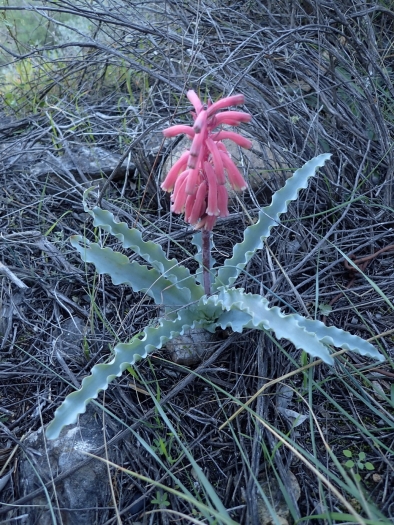Sand Lily
(Veltheimia capensis)
Sand Lily (Veltheimia capensis)
/
/

Nicola van Berkel
CC BY-SA 4.0
Image By:
Nicola van Berkel
Recorded By:
Copyright:
CC BY-SA 4.0
Copyright Notice:
Photo by: Nicola van Berkel | License Type: CC BY-SA 4.0 | License URL: http://creativecommons.org/licenses/by-sa/4.0/ | Rights Holder: Nicola van Berkel | Publisher: iNaturalist | Date Created: 2021-07-03T10:30:06-07:00 |



























Estimated Native Range
Summary
Veltheimia capensis, commonly known as Sand Lily, is a deciduous perennial bulb native to the winter rainfall regions of the Western and Eastern Cape Provinces of South Africa, where it thrives in the sheltered conditions of coastal scrub and forest margins. It typically grows to a height and width of 1-2 feet, featuring a rosette of soft, wavy-edged, green leaves. The Sand Lily blooms in late winter to spring, producing dense racemes of tubular flowers that can vary in color from yellow to pink, red, and white, depending on the cultivar. The flowers are particularly showy and make an attractive display.
The Sand Lily is valued for its striking floral display and is often used in cultivation for border plantings, container gardening, and as an accent plant in rockeries. It is relatively low maintenance, requiring minimal water once established, making it suitable for water-wise gardens. It prefers well-drained soil and can tolerate light shade to full sun exposure. While it is not prone to many diseases, it can be susceptible to root rot if overwatered. Veltheimia capensis is also occasionally grown for cut flowers due to its long vase life.CC BY-SA 4.0
The Sand Lily is valued for its striking floral display and is often used in cultivation for border plantings, container gardening, and as an accent plant in rockeries. It is relatively low maintenance, requiring minimal water once established, making it suitable for water-wise gardens. It prefers well-drained soil and can tolerate light shade to full sun exposure. While it is not prone to many diseases, it can be susceptible to root rot if overwatered. Veltheimia capensis is also occasionally grown for cut flowers due to its long vase life.CC BY-SA 4.0
Plant Description
- Plant Type: Bulb
- Height: 1-2 feet
- Width: 1-2 feet
- Growth Rate: Moderate
- Flower Color: Orange, Pink, Red
- Flowering Season: Spring, Winter
- Leaf Retention: Deciduous
Growth Requirements
- Sun: Full Sun, Part Shade
- Water: Low
- Drainage: Fast, Medium
Common Uses
Bank Stabilization, Bird Garden, Border Plant, Butterfly Garden, Drought Tolerant, Potted Plant, Rock Garden, Showy Flowers
Natural Habitat
Winter rainfall regions of the Western and Eastern Cape Provinces of South Africa, in coastal scrub and forest margins
Other Names
Common Names: Elephant’s Eye, Winter Veltheimia, Waved Leaved Veltheimia, Forest Lily, Vinterraket
Scientific Names: , Veltheimia capensis, Veltheimia viridifolia, Veltheimia glauca, Aletris capensis, Aletris glauca, Fabricia amoena, Fabricia glauca, Veltheimia deasii, Veltheimia intermedia
GBIF Accepted Name: Veltheimia capensis (L.) Redouté